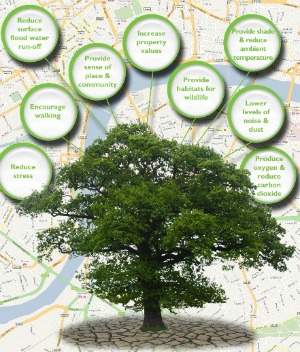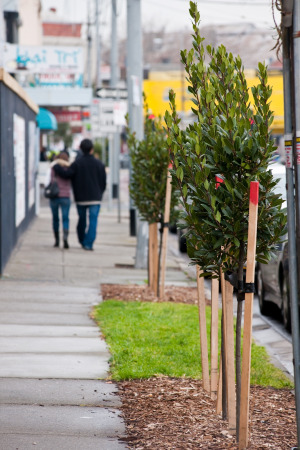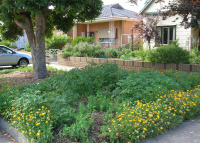Street trees and planting
 Credit Woodlandtrust.co.uk
Credit Woodlandtrust.co.uk
Trees and landscaping in the street are critical in creating an environment that people want to walk in, especially for recreation. The benefits for walkers are both aesthetic and practical, with street trees providing shelter from the sun and, to some extent, rain.
The Heart Foundation have produced a position snapshot that summarises the benefits of urban trees. Key points include:
- Trees planted along the kerb define a pedestrian zone separated from traffic, providing both real and perceived safety benefits.
- Trees can reduce the temperatures of the surfaces they shade by as much as 10-25°C.
- Street trees add significantly to the value of adjacent property, with study findings ranging from 2% to 30%.
- The environment and property value benefits have been calculated at $3.81 for every $1 spent on tree planting and maintenance.
There is substantial evidence to indicate that people benefit physically, psychologically, cognitively and socially from interaction with nature. Importantly, it is not necessary to fully immerse yourself in nature to benefit. There is evidence that people derive psychological benefit simply from being able to see trees and plants in a urban context, even when veiwed from inside buildings (Keniger et al 2013).
The City of Melbourne have produced this excellent short video highlighting the key issues in their Urban Forest Strategy, including their pragmatic approach to managing street trees in a changing climate.
Design Guidelines
 Newly planted trees in nature strip.
Newly planted trees in nature strip.
Design needs to ensure that the right size trees of the most suitable variety of species are located in the most appropriate positions. Street Trees Design Guidelines is an all encompassing report covering everything from placement to procurement. The report states that tree species should be selected such that the ultimate mature size is in scale with the relevant street, taking into consideration the site constraints, such as verge widths, overhead powerlines, building setbacks and vehicle clearances.
Section B9.3 Tree Locations and Planting of the Design and Construction Standards for Public Infrastructure Works in the Docklands Area contains extensive technical specifications for tree planting, some of the key points include:
- Maintain clear sightlines along walking and cycling routes, to avoid opportunities for concealment.
- Minimise interference with pedestrian and vehicular access.
- Maintain adequate clearance from overhead and underground services. (i.e. do not plant trees over gas and water services or under awnings)
- Provide broad canopy trees to provide shade and a pleasant environment for people on the street.
Trees and planting should always maintain clear sightlines along walking and cycling routes in order to avoid opportunities for concealment. Ground level planting should utilise low vegitation up to 700 mm and maintain an overhead clearance of 2400 mm above ground level in order to minimise interference and maintain clear sightlines.
Planting in the Nature strip

Planting in the nature strip should be encouraged as a means to make individual streets interesting, diverse and unique. Neighbourhood nature strip planting can help create an increased sense of social cohesion and community spirit between neighbours.
It is common practice for councils to allow residents to manage the nature strip outside their house. People then develop a sense of ownership of their street, with flow on benefits such as managing litter. The process of gardening in the nature strip also brings more people into the street, with multiple benefits including social interaction and increased personal safety.
Darebin City Council has a good approach to nature strips and street trees that includes a procedure for people to replant the nature strip outside their home, set out in the Nature Strip Planting Policy. This policy also alerts people to the issues they need to consider such as the access rights of utility providers and needs of pedestrians.